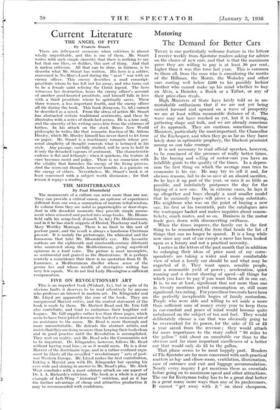FIVE ON REVOLUTIONARY ART This is an imperfect book (Wishart,
is.), but in spite of its obvious faults it deserves to be read attentively by anyone who professes an interest in modern art. Dr. Klingender and Mr. Lloyd are apparently the core of the book. They are unequivocal Marxist critics, and the central statement of the book is made by them. Mr. Herbert Read and Mr. Eric Gill also contribute, and tend to embarrass their lengthier col- leagues. Mr. Gill supplies rather less than three pages, which seem to have been jotted down on the back of a menu and are of no assistance to the cause. Mr. Read is more thorough and more uncomfortable. Ile defends the abstract artists, and insists that they are doing no more than keeping their tools clean and in good practice until the Revolution is accomplished. They wait on reality, and Mr. Read asks the Communists not to be impatient. Dr. Klingender, however, follows Mr. Read without having read him ; or so it would seem. He is a dour Marxist of the doctrinaire type, and in a rather confused argu- ment he blasts all the so-called " revolutionary " arts of post- war Western Europe. Mr. Lloyd makes the best contribution, linking a Marxist aria with Dr. Klingender but opening his eyes wide and shining in answer to Mr. Read's plea. Mr. Alick West concludes with a most salutary attack on one aspect of Dr. I. A. Richards's criticism. The book as a whole is a good
3 example of Left-Wing " historical " criticism, and as it has the further advantage of cheap and attractive production it may be recommended with confidence.










































 Previous page
Previous page